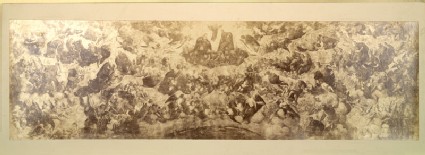Browse: 1470 objects
Photograph of a Copy of Tintoretto's "Paradise" anonymous Spanish
-
Curator’s description:
Description
The image depicts Christ and the Virgin appearing side-by-side in a glory at the upper centre, with various saints and angels arranged in a series of concentric arcs below them. A small section of the earth's surface appears in the bottom centre. A woman's head, on a much larger scale, appears just above the bottom edge in the right-hand corner.
In "The Relation between Michael Angelo and Tintoret" (§ 20 = XXI.94), Ruskin notes that 'The upper photograph in S. 50 is, however, not taken from the great Paradise, which is in too dark a position to be photographed, but from a study of it existing in a private gallery, and every way inferior. I have vainly tried to photograph portions of the picture itself.' In fact, as Cook & Wedderburn note in their comments on this passage, Ruskin was mistaken: the picture is actually housed in the Prado, Madrid, and is now regarded as a reduced copy by an artist in the school of Tintoretto, presumably for the woman whose head and shoulders are visible in the lower right corner. It reproduces Tintoretto's huge oil-painting of "Paradise" in the Sala del Maggior Consiglio of the Doge's Palace, Venice, painted between 1588 and 1592.
The photograph was first listed in the Teaching Collection in 1870, when it was included in the "Catalogue of Examples" as the upper picture in frame no. 50 in the Reference Series, above a photograph of a painting of two Venetian senators from Tintoretto's workshop. Both pictures retained their positions in the 1872 catalogue of the series. In both the "Catalogue of Examples" and "Catalogue of the Standard and Reference Series", Ruskin used the pictures in this frame as 'examples illustrating pictorial power'; the "Paradise" was an example of 'imagination as facile as it is magnificent'. In "The Relation between Michael Angelo and Tintoret", he described the "Paradise" as an example 'of the most splendid drama ... ever attained by the arts of the Middle Ages'; again, it served as an exemplar of Tintoretto's dramatic power.
Ruskin also placed copies of Tintoretto's original canvas in the Doge's Palace, made by Angelo Alessandri at intervals from 1880 to 1886, in the Museum of the Guild of Saint George (1880: R.115-R.117 & R.119; Morley, Appendix, pp. 7-8 & 20-21). A large photograph of the canvas in Venice, assembled from three prints, is also in the Guild's collection (R.237).
-
Details
- Artist/maker
-
anonymous Spanish (photographer)after a work attributed to Jacopo Robusti, called Tintoretto (1519 - 1594)
- Object type
- photograph
- Material and technique
- albumen print
- Dimensions
- 109 x 370 mm (print); 142 x 382 mm (mount)
- Inscription
- In the photograph, bottom right, apparently marked on the negative (and so printed white), but possibly painted on the painting itself: 1276.
On the back of the mount:
centre, in graphite: St·50 upper [the 't' inserted above the '·']
just to the left, the Ruskin School's stamp
- Provenance
-
Presented by John Ruskin to the Ruskin Drawing School (University of Oxford), 1875; transferred from the Ruskin Drawing School to the Ashmolean Museum, c.1949.
- No. of items
- 1
- Accession no.
- WA.RS.STD.050.a
-
Subject terms allocated by curators:
Subjects
-
References in which this object is cited include:
References
Ruskin, John, Catalogue of Examples Arranged for Elementary Study in the University Galleries (Oxford: Clarendon Press, 1870), cat. Standard no. 50
Ruskin, John, Catalogue of the Reference Series Including Temporarily the First Section of the Standard Series (London: Smith, Elder, [1872]), cat. Standard no. 50
Ruskin, John, ‘The Ruskin Art Collection at Oxford: Catalogues, Notes and Instructions’, Edward T. Cook and Alexander Wedderburn, eds, The Works of John Ruskin: Library Edition, 39 (London: George Allen, 1903-1912), 21, cat. Standard no. 50
Ruskin, John, ‘The Relation Between Michael Angelo and Tintoret. Seventh of the Course of Lectures on Sculpture Delivered at Oxford, 1870-71’, Edward T. Cook and Alexander Wedderburn, eds, The Works of John Ruskin: Library Edition, 39 (London: George Allen, 1903-1912), 22
Location
-
- Western Art Print Room





